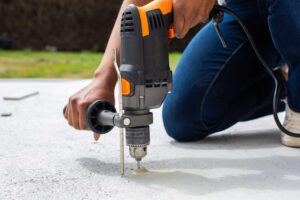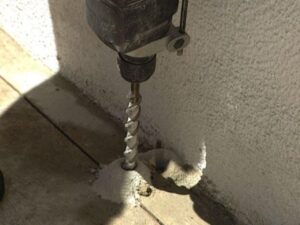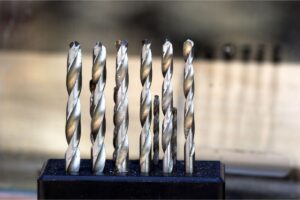Concrete is not easy to deal with. But this is an imperfection we have to overlook, at least if we are interested in the permanent, heavy-duty, weather-resistant surface it offers. It gets a bit more challenging when it is time to repair, replace, or cut our concrete. Fortunately, that is about to change.
Cutting concrete slabs, walls and floors doesn’t have to be daunting. You need to choose the right tools, protective equipment and understand how to cut concrete safely.
If you’re not confident after reading this post, or need deep or precise cuts, always contact concrete cutting experts to handle the project for you instead.
Perhaps you need to cut concrete to remove a slab, fix concrete patio drainage or renovate. So what’s the best way to cut concrete? Let’s get to it!
Types of blades for concrete cutting
Diamond Blades are made of a metal blade alongside a diamond/metal composite, usually bonded to the perimeter. The cutting forces the metal composite to wear away gradually. This bares the fresh, sharp, diamond cutting edges.
Diamond blades are somewhat costly, especially when you are getting one for a standard 7-inches circular saw. However, the high price is justified by its extended lifespan and ability to outlive and outperform most abrasive-type blades in the market.
There are two types of diamond blades:
- The Dry-cutting diamond blades
- The Wet-cutting diamond blades
The rim in dry-cutting diamond blades is either serrated or toothed. The rim cools the blade while expelling waste. These blades are ideal for making a series of slowly deepening cuts. It gets the job done without overheating the blade. However, you may need to get used to the massive dust that comes with using dry-cutting masonry. So, it is best to seal off the perimeter and the duct openings with duct tape and plastic if you are working indoors.
The wet-cutting diamond blades may come with teeth or a smooth, continuous perimeter. The introduction of water has many benefits. It reduces the dust, lubricates the blade, and cools the unit. The speed and neatness of this type of diamond blade are remarkable. However, this is only possible if and when you use a saw that can distribute water and work in a wet environment. A better and safer option will be to plug your saw into a GFCI-protected extension cord. Ask someone to direct a small stream of water right in front of the saw continuously while you cut.
You can significantly save costs by hiring a track-guided, wet-cutting saw/saw blade unit instead of buying one. This is even more advisable for a massive, one-off project. You may get walk-behind saws to saw concrete slabs and other useful hand-held saws for related construction tasks.
Before you cut a concrete floor or wall
Plumbing pipes, conduits and other things can be hidden in concrete. If you are concerned about what else you might cut, a “concrete x-ray” can tell you where cavities and metal exist. For this you’ll need a contractor with ground penetrating radar (GPR) equipment.
How to cut concrete with a circular saw
Cutting concrete with a circular saw can be a useful technique for making precise cuts in a concrete slab or wall. It’s important to follow some basic safety guidelines and use the proper equipment to ensure a successful and safe cut. Here are the steps for cutting concrete with a circular saw:
- Gather your equipment. You’ll need a circular saw with a masonry blade, a pair of safety goggles, a dust mask, and earplugs.
- Mark the cut line on the concrete with a pencil or chalk. Use a straight edge or a chalk line to ensure a straight, accurate cut.
- Set up the saw. Make sure the blade is properly tightened and the saw is in good working condition. If you’re using a corded saw, make sure the cord is clear of the blade and out of the way.
- Put on your safety gear. Make sure you’re wearing your goggles, dust mask, and earplugs to protect yourself from debris and noise.
- Wet the area you’ll be cutting. This helps to reduce the amount of dust created by the saw and makes the cut easier. You can use a hose or a wet sponge to moisten the concrete.
- Cut the concrete. Start the saw and guide it along the cut line, applying steady, even pressure. Keep the saw moving at a steady pace and don’t force it through the concrete. If you encounter any resistance, stop and check the blade to make sure it’s not damaged or dull.
- Finish the cut. When you reach the end of the cut line, stop the saw and allow it to come to a complete stop before setting it down. If the saw didn’t cut all the way through the concrete, you can use a hammer and chisel to break off the remaining pieces.
- Clean up the debris. Use a broom and dustpan to sweep up any debris and dust created by the saw. Be sure to dispose of the debris properly.
Some additional tips for cutting concrete with a circular saw:
- Use a blade specifically designed for cutting masonry. These blades have a harder and more abrasive material, such as diamond, that is able to cut through concrete.
- Make sure the blade is sharp. A dull blade will make the cut more difficult and can cause the saw to bind or stall.
- Use a guide to keep the saw straight. You can use a straight edge or a guide rail to help keep the saw on track and ensure a straight cut.
- Go slow and steady. Don’t try to force the saw through the concrete. Let the blade do the work and keep the saw moving at a consistent pace.
- Use a dust collection system. Cutting concrete generates a lot of dust, so it’s a good idea to use a dust collection system to keep the area clean and reduce the risk of inhaling dust.
- Never use a wet blade without water, dry-cutting blades work well with or without water.
- Wear the right protective gear when using concrete cutting blades, especially the dry-cutting versions.
- Always back the dry-cutting blade off when in use. Let it run free for about 30 to 45 seconds. This will ensure it doesn’t overheat.
- Avoid using undue force on the blade to cut. Instead, allow the weight of the blade and the saw to dictate the cutting force and speed.
By following these steps and taking the necessary precautions, you can safely and effectively cut concrete with a circular saw. Always remember, it is very important to wear the right safety equipment and advice.
Jake is a tool guy – think Tim Allen from Home Improvement but with a much drier sense of humor. He lives in the great state of Ohio and plays the guitar on his downtime. He also spends his time writing on all things tools and DIY-related as this is his passion.








